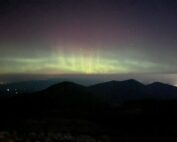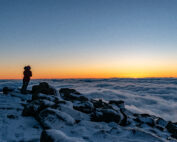How Do Frost Heaves Form?
2015-11-30 18:14:22.000 – Michael Dorfman, Weather Observer/IT Specialist
I’ve heard people ask questions, especially this time of the year, about frost heaves. Seemingly defying the laws of gravity, ice often pushes earth up with impressive force, lifting hundreds of pounds of material and potentially doing serious damage to structures in its path. How does this form?
A logical explanation to frost heaves is the expansion of water as it freezes. This would explain why ice is forced upward, however the 10% expansion in volume of frozen water does not account for the impressive distance the ice can force earth into the air.
Instead, the driving factor behind frost heaves is capillary action. If you dip the corner of a paper towel into water, you’ll see the water begin to travel up the paper. The main causes of capillary action are explained very well in this USGS article:
“Capillary action occurs because water is sticky, thanks to the forces of cohesion (water molecules like to stay close together) and adhesion (water molecules are attracted and stick to other substances). Adhesion of water to the walls of a vessel will cause an upward force on the liquid at the edges and result in a meniscus which turns upward. The surface tension acts to hold the surface intact. Capillary action occurs when the adhesion to the walls is stronger than the cohesive forces between the liquid molecules. The height to which capillary action will take water in a uniform circular tube is limited by surface tension and, of course, gravity.”
So, that explains why capillary action occurs in test tubes and paper. It is very similar in soil-water travels upwards between porous particles. The temperature gradient within the soil also helps to pull moisture upward to the surface.
 Water permeating through soil layers toward the surface causes frost heaves. Courtesy of Wikipedia-Open Source.
Water permeating through soil layers toward the surface causes frost heaves. Courtesy of Wikipedia-Open Source.
Capillary flow is strongest through semi-porous material. Therefore, clay would be too dense to promote capillary action and gravel too spread out to promote capillary water movement. A review released by Edwin Chamberlain of the Cold Regions Research and Engineering Laboratory indicated that materials with particles greater than 10% of the particles less than 0.075 mm in diameter supported frost formation.
Do you have a weather question? Get it answered by the meteorologists here on the summit every Monday. Simply tag your question on social media with #mwometmonday!
Michael Dorfman, Weather Observer/IT Specialist
From Weather Observer to Intern, to Observer Again
From Weather Observer to Intern, to Observer Again By Madelynn Smith As I rode in the backseat of our Obs van up the Auto Road for the first time as a full-time employee at
From Mountains to More Mountains
From Mountains to More Mountains: This Time with Stronger Winds By Alyssa Bélanger On the observation deck in high winds. Hello there! My name is Alyssa Bélanger and I am a fall
From Summit to Sign-Off: My Farewell to the Rockpile
From Summit to Sign-Off: My Farewell to the Rockpile By Amy Cotter Enjoying my last Mount Washington sunset (for now) on September 13, 2025. After two incredible years with the Mount Washington




